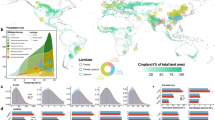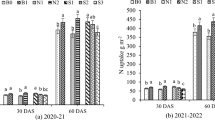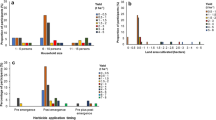Abstract
Mucuna pruriens has emerged as a successful forage or green manure legume for use in the smallholder animal-livestock systems of Zimbabwe. The efficiency of N recovery from mucuna residues in subsequent maize crops can be low and the loss of nitrate nitrogen from the soil profile prior to maize N demand is proposed as a reason for this. An experiment was established in the 1999–2000 wet season at seven on-farm sites in a communal farming district of Zimbabwe (average rainfall 650–900 mm) on acidic (pH < 5), and inherently infertile soils with texture ranging from sandy/sandy loam (n = 5) to clay (n = 2). Improved fallows of mucuna grown for 19 weeks produced between 4.7 and 8.5 t/ha dry matter (DM) at the sandy/sandy loam sites and between 9.5 and 11.2 t/ha DM at the clay sites. This biomass was then either cut and removed as hay, or ploughed in as a green manure. Weedy fallow treatments, which represent typical farmer practice, produced 3.3–6.3 t/ha DM. A maize crop was then grown on these same sites in the following 2000–2001 wet season and the dynamics of soil N and C and maize production were investigated. Where mucuna was green manured, a positive linear response (r2 = 0.72) in maize yield to increasing mucuna biomass (containing 101–348 kg N/ha) was found. On the sandy sites, and where no P fertiliser was applied to the previous mucuna phase, a maize grain yield of 2.3 t/ha was achieved following the mucuna green-manure system; this was 64% higher than the maize yield following the weedy fallow and 100% higher than the maize yield following the mucuna ‘removed’ hay system. Apparent nitrogen recoveries in the range of 25 to 53% indicate that there are large quantities of nitrogen not utilised by the subsequent maize phase. The loss of 73 kg/ha of nitrate N from the soil profile (0–120 cm) early in the wet season and prior to maize N demand is proposed as a reason for low N recovery. No change in labile C (measured with 333 mM KMnO4) was detected through the soil profile at this time and it is suggested that labile C movement occurred between the sampling times.
Similar content being viewed by others
References
Anonymous 1984. Zimbabwe 1:1000000 Natural Regions and Farming Areas. Second edition. Surveyor-General, Harare, Zimbabwe.
Basillio-Sanchez P. 2002. Plant Residue Decomposition and Dynamics of Residue Derived Carbon, Nitrogen and Sulfur. Ph.D. 0Thesis, University of New England, Armidale, Australia.
Becker M., Ladha J.K. and Ottow J.G.C. 1994. Nitrogen losses and lowland rice yield as affected by residue nitrogen release. Soil Sci. Soc. Am. J. 58: 1660–1665.
Becker M., Ladha J.K. and Ali M. 1995. Green manure technology: Potential, usage and limitations. A case study for lowland rice. Plant Soil 174: 181–194.
Blair G.J., Lefroy R.D.B. and Lisle L. 1995. Soil carbon fractions based on their degree of oxidation, and the development of a carbon management index for agricultural systems. Austr. J. Agric. Res. 46: 1459–1466.
Bray R.H. and Kurtz L.T. 1945. Determination of total, organic and available forms of phosphorus in soils. Soil Sci. 59: 39–45.
Bruneau P.M.C. and Twomlow S.J. 1999. Hydrological and physical responses of a semi-arid sandy soil to tillage. J. Agric. Eng. Res. 72: 385–391.
Carsky R.J., Oyewole B. and Tian G. 1999. Integrated soil management for the savanna zone of W. Africa: legume rotation and fertiliser N. Nutr. Cycl. Agroecosyst. 55: 95–105.
Carsky R.J., Oyewole B. and Tian G. 2001. Effect of phosphorus application in legume cover crop rotation on subsequent maize in the savanna zone of West Africa. Nutr. Cycl. Agroecosyst. 59:151–159.
Chikowo R., Mapfumo P., Nyamugafata P. and Giller K. 2004a. Mineral N dynamics, leaching and nitrous oxide losses under maize following two-year improved fallows on a sandy loam soil in Zimbabwe. Plant Soil 259: 315–330.
Chikowo R., Mapfumo P., Nyamugafata P. and Giller K. 2004b. Maize productivity and mineral N dynamics following different soil fertility management practices on a depleted sandy soil in Zimbabwe. Agric. Ecosyst. Environ. 102: 119–131.
Conteh A., Blair G.J., Lefroy R. and Whitbread A. 1999. Labile organic carbon determined by permanganate oxidation and its relationships to other measurements of soil organic carbon. Humic Sub. Env. 1: 3–15.
Delve R.J., Cadisch G., Tanner J.C., Thorpe W., Thorne P.J. and Giller K.E. 2001. Implications of livestock feeding management on soil fertility in the smallholder farming systems of sub-Saharan Africa. Agric. Ecosyst. Environ. 84: 227–243.
FAO-UNESCO 1974. Soil Map of the World 1:5000000. Volume I. Legend. UNESCO, Paris, France.
Fischler M. and Wortmann C.S. 1999. Green manures for maizebean systems in eastern Uganda: Agronomic performance and farmer perceptions. Agrofor. Syst. 47: 123–138.
Giller K.E. and Cadisch G. 1995. Future benefits from biological nitrogen fixation: An ecological approach to agriculture. Plant Soil 174: 255–277.
Giller K., Rowe E., de Ridder N. and van Keulen H. 2004. Resource use dynamics and interactions in the tropics: Moving to the scale of the 'livelihood'. Agricult. Syst. (in press).
Heisey P.W. and Mwangi W. 1996. Fertiliser use and maize production in sub-Saharan Africa. Economics working paper 96-01, CIMMYT, Mexico, DF., Mexico, pp. 8–11.
Hikwa D., Murata M., Tagwira F., Chiduza C., Murwira H., Muza L. and Waddington S.R. 1998. Performance of green manure legumes on exhausted soils in northern Zimbabwe: A soil fertility network trial. In: Waddington S.R., Murwira H.K., Kumwenda J.D., Hikwa D. and Tagwira F. (eds), Soil Fertility Research for Maize-Based Farming Systems in Malawi and Zimbabwe. Proceedings of the Soil Fertility Net Results and Planning Workshop held from 7 to 11 July 1997 at Africa University, Mutare, Zimbabwe. Soil Fert Net and CIMMYT-Zimbabwe, Harare, Zimbabwe, pp. 81–84.
ICRISAT/MAI 2000. Cost effective soil fertility management options for smallholder farmers in Malawi. ICRISAT, Bulawayo, Zimbabwe, and Ministry of Agriculture and Irrigation, Lilongwe, Malawi, p. 9.
Jiri O. 2003. Integration of forage legumes into smallholder farming systems, with emphasis on velvet bean [Mucuna pruriens (L) DC var. utilis (Wall. Ex. Wight) Baker ex Burck]. Master of Philosophy Thesis. University of Zimbabwe, Harare, Zimbabwe.
Konboon Y., Blair G.J., Lefroy R.D.B. and Whitbread A.M. 2000. Tracing the nitrogen, sulfur and carbon released from plant residues in a soil/plant system. Austr. J. Soil Res. 38: 699–710.
Linquist B., Senguxa P., Whitbread A.M. and Changpengsay M. 1999. The potential of on-farm residues for improving rainfed lowland rice productivity in the Lao PDR. In: Whitbread A.M. and Blair G.J. (eds), Integrated Nutrient Management in Farming Systems in Southeast Asia and Australia. Proceedings of an International Workshop held at the National Agricultural Research Centre, Vientiane, Laos, 21-22 April 1999, pp. 37–42.
Loginow W., Wisniewski W., Gonet S.S. and Ciescinska B. 1987. Fractionation of organic carbon based on susceptibility to oxidation. Pol. J. Soil Sci. 20: 47–52.
Mushayi P.T., Waddington S.R. and Chiduza C. 1999.Low efficiency of nitrogen use by maize on smallholder farms in subhumid Zimbabwe. In:Maize Production Technology for the Future: Challenges and Opportunities.Proceedings of the Sixth Eastern and Southern Africa Regional Maize Conference, 21-25 September 1998,Addis Ababa, Ethiopia. CIMMYT and EARO, pp. 278–281.
Muhr L., Tarawali S.A., Peters M. and Schultze-Kraft R. 1999. Forage legumes for improved fallows in agropastoral systems of subhumid West Africa. I. Establishment, herbage yield and nutritive value of legumes as dry season forage. Trop. Grass 33:222–233.
Naklang K., Whitbread A., Lefroy R., Blair G., Wonprasaid S., Konboon Y. and Suriya-Arunroj D. 1999. The management of rice straw, fertilisers and leaf litters to enhance sustainability of cropping systems in northeast Thailand. 1. Soil carbon dynamics. Plant Soil 209: 21–28.
Okalebo J.R., Gathua K.W. and Woomer P.L. 1993. Laboratory methods of soil and plant analysis: a working manual. TSBF.
Palm C.A., Giller K.E., Mafongoya P.L. and Swift M.J. 2001. Management of organic matter in the tropics: translating theory into practice. Nutr. Cycl. Agroecosyst. 61: 63–75.
Pengelly B.C., Whitbread A., Maziawana P.R. and Mukombe N. 2003. Tropical forage research for the future-better use of research resources to deliver adoption and benefits to farmers.Trop. Grasslands. 37: 207–216.
Piha M.I. 1993. Optimising fertiliser use and practical rainfall capture in a semi-arid environment with variable rainfall. Exp. Agric. 29: 405–415.
Rayment G.E. and Higginson F.R. 1992. Australian Laboratory Handbook of Soil and Water Chemical Methods. Inkata Press, Melbourne, Australia, 138 pp.
Sakala D., Ligowe I. and Kayira D. 2003. Effect of mucuna-maize rotations on short fallows on maize yields from abandoned fields in Malawi. In: ICRISAT-Zimbabwe and SDARMP, Target Newsletter. Harare, Zimbabwe. Soil Fert Net-CIMMYT 35: 4–5.
Sanginga N., Ibewiro B., Houngnandan P., Vanlauwe B., Okogun J.A., Akobundu I.O. and Versteeg M. 1996. Evaluation of symbiotic properties and nitrogen contribution of mucuna to maize grown in the derived savanna of West Africa. Plant Soil 179:119–129.
Singh A. 1963. A critical evaluation of green-manuring experiments on sugar cane in north India. Emp. J. Exp. Agric. 31: 205–212.
Shamudzarira Z. and Robertson M.J. 2002. Simulating the response of maize to nitrogen fertiliser in semi-arid Zimbabwe. Exp. Agric. 38: 79–96.
Snapp S.S., Mafongoya P.L. and Waddington S. 1998. Organic matter technologies for integrated nutrient management in smallholder cropping systems of southern Africa. Agric. Ecosyst. Environ. 71: 185–200.
Tian G., Kolawole G.O., Kang B.T. and Kirchof G. 2000. Nitrogen fertiliser replacement indexes of legume cover crops in the derived savanna of West Africa. Plant Soil 224: 287–296.
Walkley A. 1947. A critical examination of a rapid method for determining organic carbon in soils-effect of various digestion conditions and of inorganic soil constituents. Soil Sci. 63: 251–264.
Whitbread A., Blair G., Lefroy R., Naklang K., Wonprasaid S., Konboon Y. and Suriya-Arunroj D. 1999a. The management of rice straw, fertilisers and leaf litters to enhance sustainability of cropping systems in Northeast Thailand. 2. Rice yields and nutrient balances. Plant Soil 209: 29–36.
Whitbread A.M., Chanphengsay M., Linquist B., Senguxa P., Blair G.J., Vongsouthi S. and Phengsounanna V. 1999b. Sesbania rostrata as a green manure and phosphorus management for lowland rice production in Lao P.D.R. In: Whitbread A.M. and Blair G.J. (eds), Integrated Nutrient Management in Farming Systems in Southeast Asia and Australia. Proceedings of an International Workshop held at the National Agricultural Research Centre, Vientiane, Laos, 21-22 April 1999, pp. 28–36.
Whitbread A.M., Blair G.J. and Lefroy R.D.B. 2000. Managing legume leys, residues and fertilisers to enhance the sustainability of wheat cropping systems in Australia 2. Soil physical fertility and carbon. Soil Tillage Res. 54: 77–89.
Author information
Authors and Affiliations
Rights and permissions
About this article
Cite this article
Whitbread, A.M., Jiri, O. & Maasdorp, B. The effect of managing improved fallows of Mucuna pruriens on maize production and soil carbon and nitrogen dynamics in sub-humid Zimbabwe. Nutrient Cycling in Agroecosystems 69, 59–71 (2004). https://doi.org/10.1023/B:FRES.0000025291.62043.11
Issue Date:
DOI: https://doi.org/10.1023/B:FRES.0000025291.62043.11




